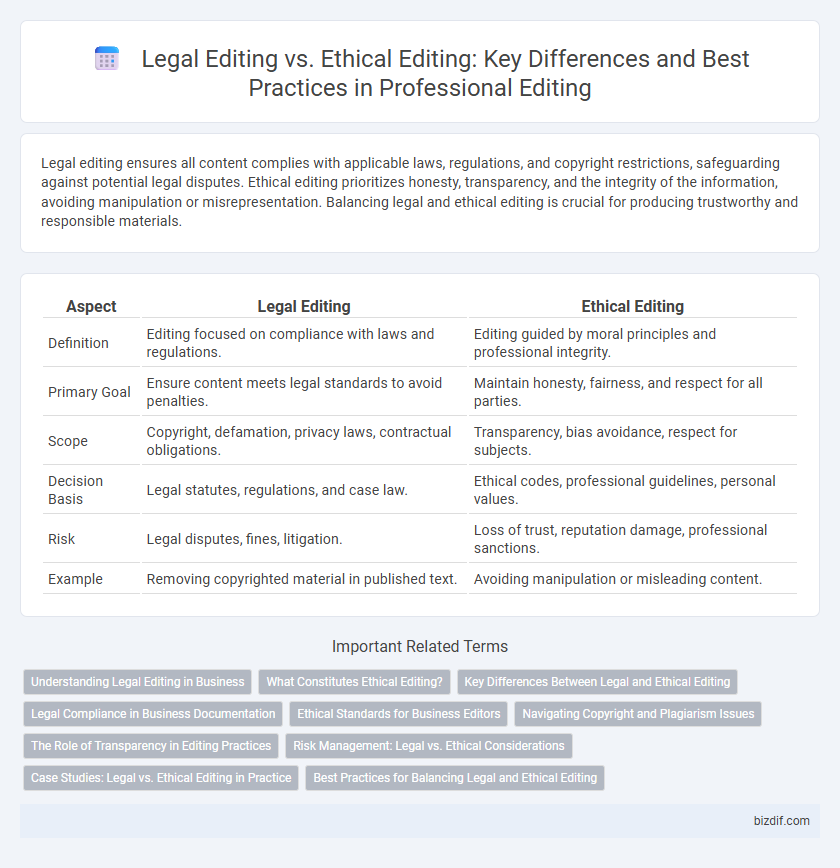Legal editing ensures all content complies with applicable laws, regulations, and copyright restrictions, safeguarding against potential legal disputes. Ethical editing prioritizes honesty, transparency, and the integrity of the information, avoiding manipulation or misrepresentation. Balancing legal and ethical editing is crucial for producing trustworthy and responsible materials.
Table of Comparison
| Aspect | Legal Editing | Ethical Editing |
|---|---|---|
| Definition | Editing focused on compliance with laws and regulations. | Editing guided by moral principles and professional integrity. |
| Primary Goal | Ensure content meets legal standards to avoid penalties. | Maintain honesty, fairness, and respect for all parties. |
| Scope | Copyright, defamation, privacy laws, contractual obligations. | Transparency, bias avoidance, respect for subjects. |
| Decision Basis | Legal statutes, regulations, and case law. | Ethical codes, professional guidelines, personal values. |
| Risk | Legal disputes, fines, litigation. | Loss of trust, reputation damage, professional sanctions. |
| Example | Removing copyrighted material in published text. | Avoiding manipulation or misleading content. |
Understanding Legal Editing in Business
Legal editing in business ensures all documents comply with applicable laws and regulations, reducing the risk of litigation and financial penalties. It involves scrutinizing contracts, agreements, and corporate communications for clarity, accuracy, and legal terminology adherence. Understanding legal editing helps businesses maintain regulatory compliance and uphold contractual obligations effectively.
What Constitutes Ethical Editing?
Ethical editing involves maintaining the integrity and intent of the original content while ensuring accuracy, clarity, and fairness without misrepresentation or plagiarism. Editors must respect authors' intellectual property rights, avoid altering meaning or context, and disclose any conflicts of interest. Upholding confidentiality and adhering to professional standards are crucial components that distinguish ethical editing from merely legal compliance.
Key Differences Between Legal and Ethical Editing
Legal editing involves ensuring that content complies with applicable laws, regulations, and copyright standards, focusing on avoiding legal liabilities and infringement. Ethical editing emphasizes adherence to moral principles such as honesty, fairness, and respect for the author's intent, prioritizing transparency and accuracy in representation. The key differences lie in legal editing's focus on regulatory compliance and risk avoidance, versus ethical editing's commitment to integrity and ethical responsibility in communication.
Legal Compliance in Business Documentation
Legal editing ensures business documentation strictly adheres to laws, regulations, and contractual obligations, minimizing risks of litigation and penalties. Ethical editing emphasizes transparency, accuracy, and fairness, fostering trust and credibility without compromising legal standards. Prioritizing legal compliance in business documents protects companies from regulatory scrutiny and enforces accountability in corporate communications.
Ethical Standards for Business Editors
Ethical editing in business prioritizes transparency, accuracy, and fairness, ensuring content is truthful and respects confidentiality. Unlike legal editing, which focuses on compliance with laws and regulations, ethical standards emphasize integrity and accountability in representing information. Business editors adhere to industry codes of ethics to maintain trust and credibility with audiences and stakeholders.
Navigating Copyright and Plagiarism Issues
Legal editing rigorously ensures compliance with copyright laws by verifying permission for content use and maintaining proper citations, thereby preventing infringement risks. Ethical editing emphasizes originality and transparency, actively detecting and addressing plagiarism to uphold the integrity of the work. Navigating both legal and ethical dimensions requires editors to balance strict adherence to intellectual property rights with maintaining honest representation of authorship.
The Role of Transparency in Editing Practices
Transparency in editing practices ensures clear communication of changes made to legal documents and ethical guidelines, fostering trust and accountability. Legal editing demands strict adherence to accuracy and compliance with statutory requirements, while ethical editing emphasizes honesty and the avoidance of misrepresentation. Maintaining transparency allows editors to uphold integrity and protect all stakeholders involved in the editing process.
Risk Management: Legal vs. Ethical Considerations
Legal editing involves ensuring compliance with laws such as copyright, libel, and confidentiality to mitigate risks of litigation and penalties. Ethical editing emphasizes maintaining the integrity and fairness of content, avoiding plagiarism, and respecting the author's intent to uphold professional standards and trust. Balancing these considerations reduces both legal liabilities and ethical breaches, safeguarding reputations and fostering credibility.
Case Studies: Legal vs. Ethical Editing in Practice
Case studies in legal editing highlight the importance of precise compliance with copyright laws and confidentiality agreements, ensuring documents meet statutory and contractual obligations. Ethical editing case studies emphasize maintaining integrity by avoiding manipulation or bias, preserving the author's original voice while promoting honesty and transparency. Comparing these approaches demonstrates how legal editors prioritize adherence to regulations, whereas ethical editors focus on moral responsibilities in content presentation.
Best Practices for Balancing Legal and Ethical Editing
Effective legal editing requires strict adherence to copyright laws and confidentiality agreements while ensuring the accuracy of legal citations and terminology. Ethical editing prioritizes transparency, respect for authors' intent, and avoidance of bias or misrepresentation in the content. Balancing legal and ethical editing involves implementing clear guidelines for intellectual property rights, maintaining open communication with authors, and applying consistent standards that uphold both legal compliance and ethical integrity in the editorial process.
Legal Editing vs Ethical Editing Infographic

 bizdif.com
bizdif.com